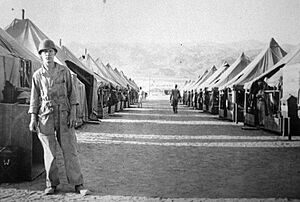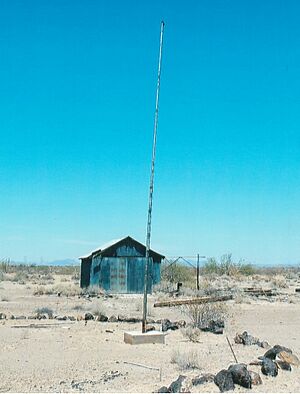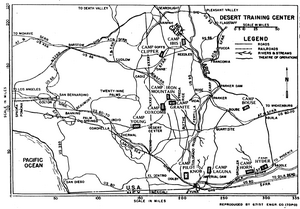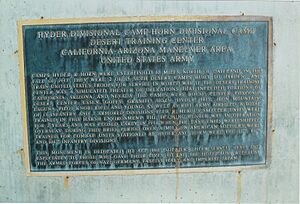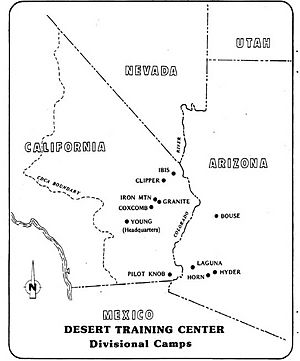Camp Hyder facts for kids
Camp Hyder was a special training base for the US Army in Arizona. It was part of a much larger training area called the Desert Training Center. This big center was mostly in Riverside County, California. The main base for the Desert Training Center was Camp Young. This is where famous General Patton's 3rd Armored Division was stationed.
Camp Hyder was located about 2 miles (3.2 km) south of a town called Hyder, Arizona. It was also just north of the Gila River. This camp was about 60 miles (97 km) east of Yuma, Arizona, and close to another camp called Camp Horn. Interestingly, Camp Hyder was built on the site of an even older military base from the 1890s.
Contents
Training for War: Camp Hyder's Story
Camp Hyder was built in August 1942. Its main goal was to get American soldiers ready for battle during World War II. Specifically, troops trained here to fight in the deserts of North Africa. They were preparing to face the enemy forces there.
The 369th Engineer Regiment built Camp Hyder. When it was finished, the camp had everything soldiers needed. There were shower buildings and latrines (bathrooms). It even had an outdoor theater for entertainment! The soldiers slept in tents set up on wooden frames. The camp also had two huge 10,000-gallon water tanks and a water treatment plant to make sure everyone had clean water.
What Soldiers Learned at Camp Hyder
Many different groups of soldiers trained at Camp Hyder. For example, the 77th Infantry Division trained here for six months in 1943. After them, the 104th Infantry Division moved in for their training.
Soldiers at Camp Hyder learned how to use many weapons. The camp had firing ranges for machine guns (like .30- and .50-caliber). They also practiced with artillery. An important part of their training was learning how to use anti-tank mines. The army used real ammunition for these exercises, so there are still warning signs at the site today.
Unlike some other camps, Camp Hyder did not have a lot of large tank training. Most troops arrived at Camp Hyder by train, as the camp had its own rail station. Another train station nearby, in Sentinel, Arizona, was also used. In total, over 13,000 troops trained at Camp Horn and Camp Hyder combined. The camp was closed in May 1944, after many soldiers had completed their training and gone overseas.
Dateland Airfield: A Nearby Training Spot
Southwest of Camp Hyder was the Dateland Air Force Auxiliary Field. This airfield was named after the nearby road stop, Dateland, Arizona. The landing strip was used to help with the camp's training activities.
How Airplanes Helped Training
Small planes, like the L-4 Piper Aircraft, used this runway. These planes helped soldiers watch the huge training grounds from the air. The runway was also long enough for bigger planes to use in training exercises.
The United States Army Air Forces opened this airfield on January 1, 1943. It was also used for Air Forces training by the 3037th Army Air Force Base Unit. The landing strip was managed by the Yuma Army Airfield in Arizona.
Markers: Remembering the Camps
There are special markers at these sites that tell us about their history.
Camp Hyder & Horn Marker
A marker at the Camp Hyder site tells us:
- Camps Hyder and Horn were set up in late 1943.
- They were two of 15 desert camps built to prepare United States troops for World War II.
- The Desert Training Center was like a huge practice battlefield. It covered parts of California, Arizona, and Nevada.
- Many camps were part of this center, including Bouse, Clipper, Coxcomb, and others.
- A total of 13 infantry divisions and 7 armored divisions, plus many smaller groups, trained in this tough desert environment.
- The training center operated for two years and closed in early 1944.
- During this short time, over a million American soldiers trained for combat.
- The 77th, 81st, and 104th Infantry Divisions were some of the units that trained at Hyder and Horn.
- This monument honors all soldiers who served here. It especially remembers those who gave their lives to help bring an end to the war and defeat the forces that threatened freedom.
- This marker was put up in 2002 by several groups, including Dateland Elementary School.
Dateland Army Air Field Marker
Another marker at the Dateland Air Force Auxiliary Field site says:
- Dateland Army Air Field was started on January 1, 1943.
- This spot was chosen because it had water and was close to the Yuma Gunnery Range.
- Construction finished on June 1, 1943.
- Dateland AAF was a smaller base connected to Yuma Army Air Field, which was a school for advanced flying.
- Other gunnery ranges were also set up nearby.
- The base was first for training with single-engine planes. But in September 1943, it changed to train with twin-engine planes.
- Troops were stationed here starting July 8, 1943. They kept the base safe and running.
- They also helped several flying groups. For example, Mather Army Air Field based 60 B-25J gun ships here for a month in late 1943 and early 1944. They flew 11,000 hours of training.
- This monument honors all the soldiers and airmen who served here. It especially remembers those who lost their lives during training and in the skies over Europe, Asia, and the Pacific, as they helped achieve victory in the war.


